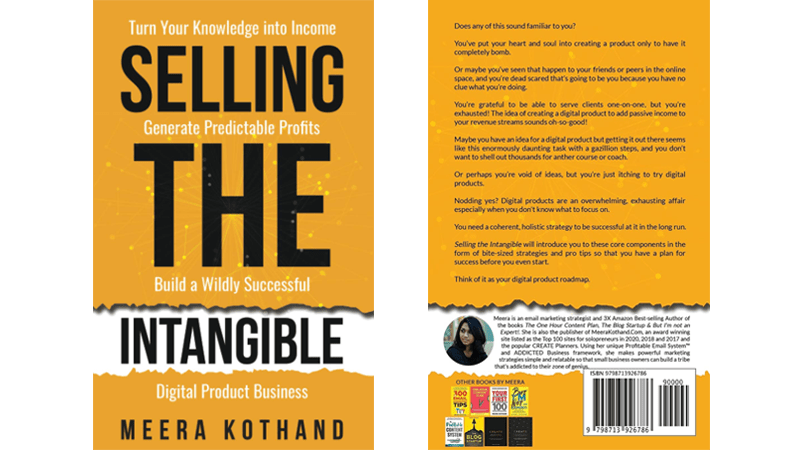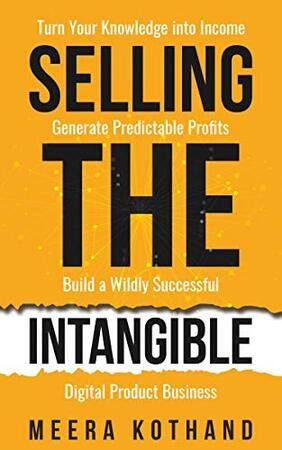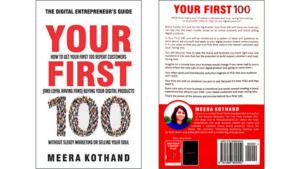Table of Contents
Selling The Intangible by Meera Kothand
About the Author
Meera is an Amazon best selling Author with books in various aspects of online business. She is the founder of CREATE-planners and MeeraKothand which has been an award winning top 100 site for three years in a row. She explains complex topics in a very simple so it benefits a variety of people. Through her books and courses meera has taught over 80,000 students and readers. She has been featured on various sites like Marketing Profs, Proof to Product, Addicted2Success and podcasts. In this book she takes a simple step by step approach to teaching how to sell digital products.
Book summary – Key insights
Many of us have expectations when we start to sell digital products. For example “how in the hell is someone making $30,000 a month selling ebooks and courses”. At the beginning I was not able to make $1000 in 6 months. This can be disturbing and frustrating and can derail you of your goal. No matter which stage you are in whether you have a digital product or you have failed selling your digital products I understand your situation.
The first thing to consider before we jump into what to do is the why!
You have to find a digital product that solves a nagging point. Remember that you are not only selling a digital product but a brand. So the question shouldn’t be what product should I create but what is my vision and business model. There are many wrong assumption that will paralyse you and you must remember to put them aside.
Some of the main false assumptions that people have are the following:
- One digital product will change your life
- Courses are digital products holy grails
- If no one bought it the first time then the product is a failure
- Your not expert enough to create a digital product
- There is one magic formula
Now before you start creating your product remember that there are two main points about digital products to consider
- Always create the first product in a way that is easy to sale
- Arrange your products in a way that your audience can return to buy more
You should arrange your product offering in a stage manner. The first stage should be free content or small products. This could be blog posts, youtube, free products or even small (low cost) paid products. The next stages should be memberships(subscriptions) and then bigger more complicated products.
Before you start building your product you should find out where in the customer journey are your customers. The customer journey is basically how much the customer knows about the product (or the solution) before they get to your product. For example if the customers knows nothing about the problem they are at stage 1 of the customer journey. This means that they do not even know(unaware) that the problem exists. If your customers are at a later stage it is much easier to sell them a product since they are already aware of a solution. They may even have tried other solutions before seeing your solution (product). Run surveys and interact with customers to find which stage of the journey are your customers in.
Many people create a product and later realise people don’t buy it. Instead of focusing on your product start thinking about your offer. A great product with a weak offer will get you nowhere. In order to have a great offer you consider the following points:
- Determine where the product is going to be
- Consider the competition and their offers
- Do an audit of your competitors product
- Focus on aspects like central idea, methodology and why should buyers choose you
Start going from the skeleton to the flesh! Create an outline for your product. In order to create an outline consider two points. The first point is the current situation and the second is the desired situation or the end goal. You can list all the steps required for taking someone from point A to point B. Then list all the milestones and goals required for these steps. This will help you create all the parts and materials your need to accomplish your goal and create your product.
Creating an outstanding sales page is your next step. I structure my sales page into 9 different parts which includes who, hook, pain points, change, product inventory, myth, objections, FAQ and Action.
The perfect pricing is also really important for your product. In order to set the right price follow two rules
1. The value of the outcome
2. How much the outcome is worth for your customer
Always highlight the benefits and not the features. Customers pay when they are in pain and want to fix a problem. It is up to you to reflect this in your offer and try to fix their problems.
Another way is to use a price spectrum by plotting prices from your competitors and see where you fall on the spectrum.
So how do you start selling. In todays online space the power has moved from the sellers to buyers. People have got used to various online selling techniques. You have to use the persistent nurturing and knocks on the door technique to get result.
When we get to the launch phase there are basically three steps. These steps include prelaunch phase, sales page and urgency. The prelaunch phase means that you have to get customers ready at least 3 to four weeks before sale. The sales phase is when customers are able to actually purchase the product. The urgency phase is that you have to induce some kind of urgency in your customers so they will take action. For example by limited timing or bonuses. When you want to sell digital products, no matter what type of launch you have you need to include the three steps mentioned earlier.
After the launch phase you will need to scale your offer. The evergreen funnel is one of the best methods to scale your products. A funnel is basically a journey your customer takes until they purchase a product. Evergreen funnels can include various stages however a typical three stage funnel includes a blog post(or content) followed by a thank you page and then an email sequence (usually up to 10 emails).
You will need several tools to basically to sell digital products. The tools should include
- A landing page (sales page) creation tool
- A shopping cart tool for payment purpose
- A secure platform to upload and host your product
- A Countdown timer for inducing urgency in buyers
- An automated email service like Mailchimp
So remember you have to take all the following 12 crucial steps in order to go from the beginning to the end. If you want to sell digital products and get results remember not to jump any steps.
- Products place in ecosystem
- Defining and validating your offer
- defining product parameters
- Branding
- Your sales page outline
- Revenue goal and size of your launch list
- Prelaunch and launch content
- Marketing your campaign
- Creating your product
- Prelaunch and sales preparation
- Prelaunch, cart open and sales execution
- Post launch





